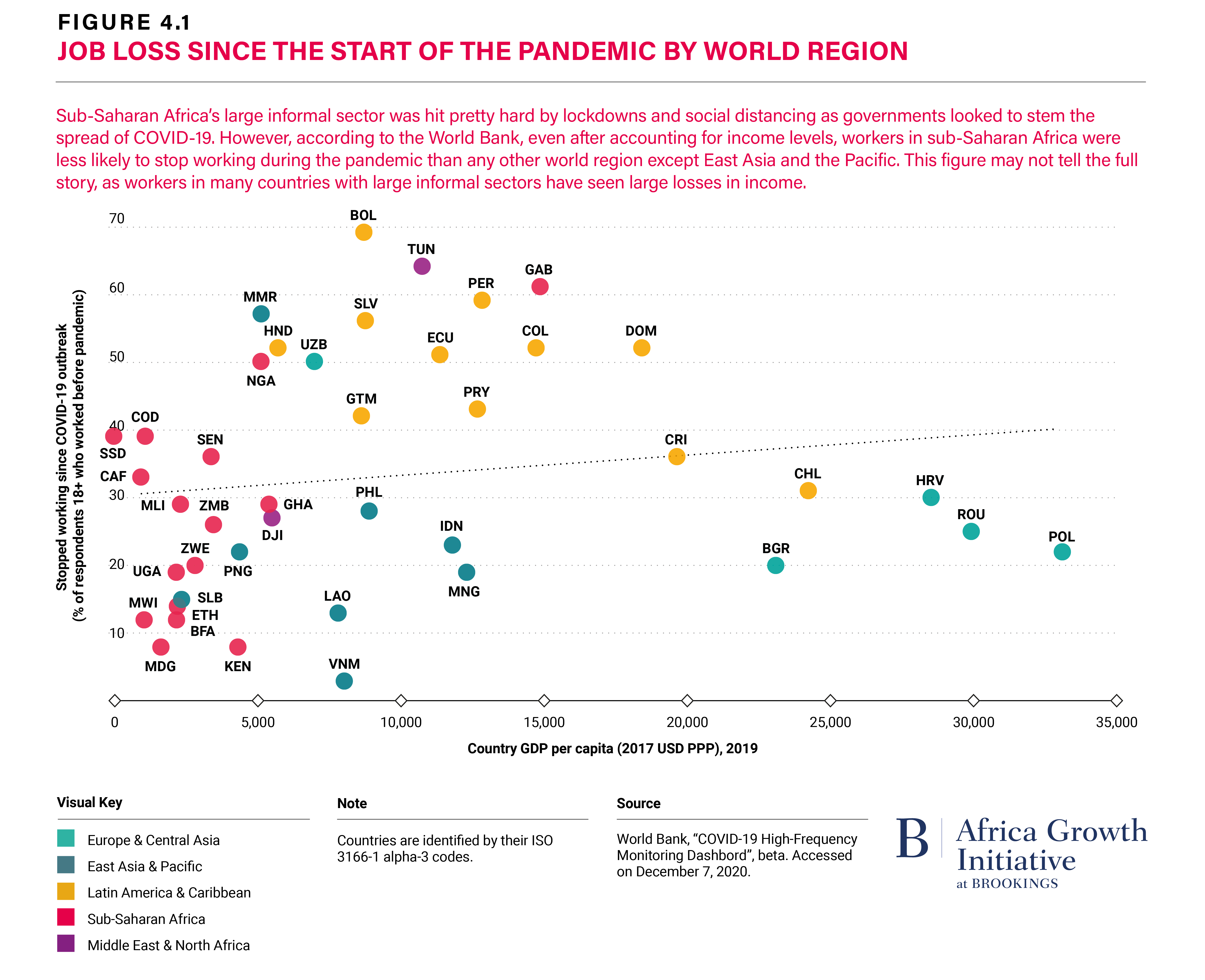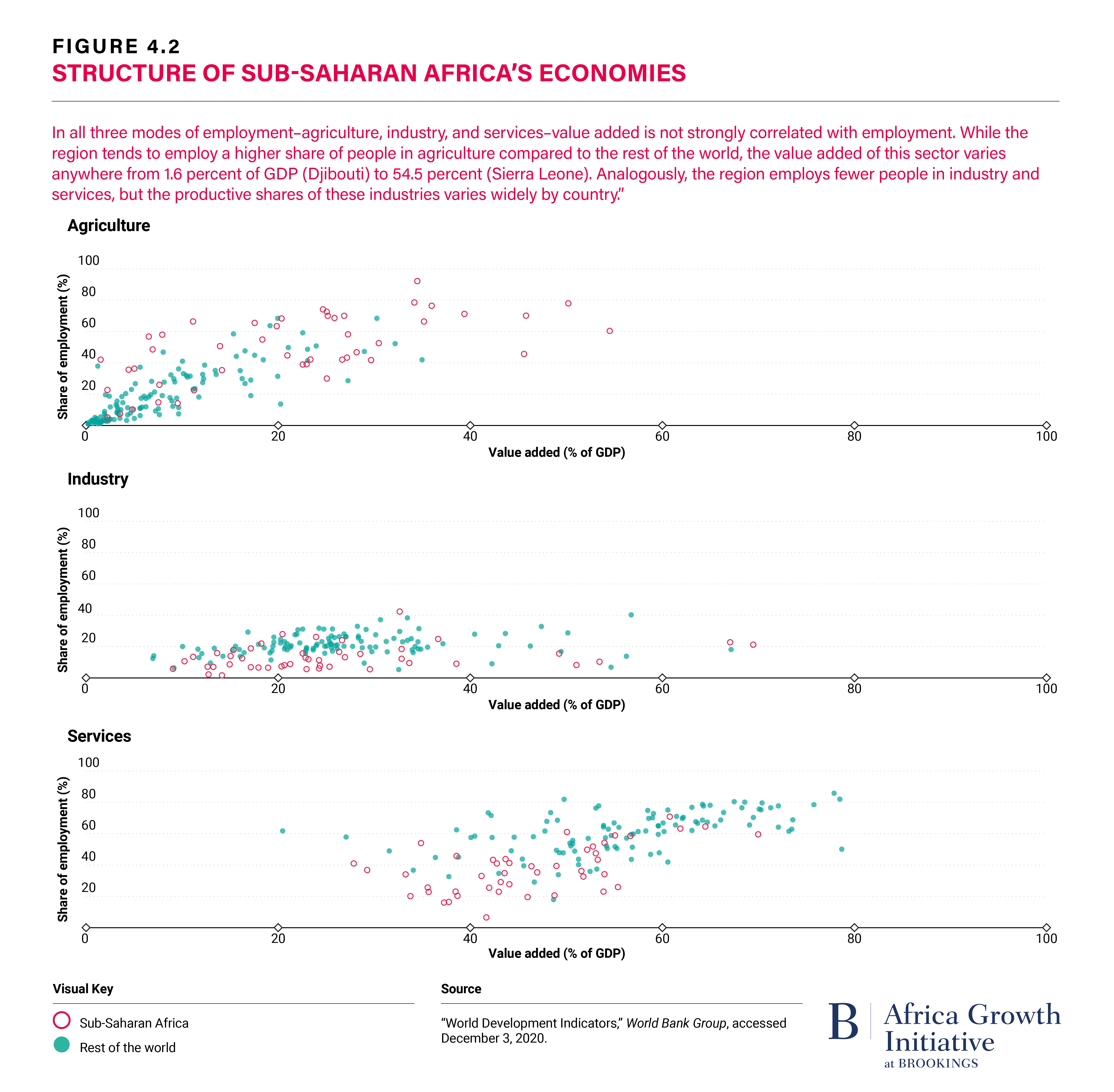04
Private sector leadership:
Building African businesses and creating jobs
A marriage of more than convenience: How COVID-19 can bring public & private sectors together in Africa
Beyond the staggering tragedy that is the death and illness of thousands of people the world over, the COVID-19 pandemic has also brought unprecedented economic disorder, decimating economies and the livelihoods of citizens in rich and poor nations alike. The International Trade Centre projected that, globally, one in every five micro, small, and medium enterprises (MSMEs) will go bankrupt in 2020—an alarming number considering that, in Africa, this category of business provides nearly 80 percent of sorely needed youth employment. The pandemic is estimated to push about 40 million people in the region into extreme poverty in 2020. That kind of abrupt uptick in suffering has not been seen in Africa since the 1980s.
From a macro perspective, the pandemic will compound the already declining level of foreign direct investment (FDI) in Africa, exacerbating in turn the serious liquidity and capital constraints that restrain enterprise growth and keep African economies uncompetitive. Weak enterprise growth means a shrinking tax base and a deepening of fiscal incontinence. Governments in such dire straits are rarely the guardians of an “enabling environment for innovation, investment and industrialization,” thus a vicious poverty circle perpetuates itself. The International Monetary Fund’s recovery price tag of $1.2 trillion and the financing gap of $345 billion resulting from FDI and domestic revenue shortfalls put numbers to the widely felt anxiety.
For African economies to survive these shocks, policymakers and private sector actors must work more closely together than ever before. They must jointly take action to protect the economic gains of recent decades as well as pave the way for a smooth implementation of the African Continental Free Trade Area (AfCFTA)—which promises a $1.2 billion consumer market to African businesses and $4 trillion in estimated private and business-to-business spending. Thankfully, they already are.

Technology and partnership will be key to recovery
Experts agree that technology and its corollary, innovation, will be primary drivers of any kind of post-COVID-19 recovery strategy as well as long-term sustained economic growth. Already, the pandemic has underscored the importance of e-commerce, remote working arrangements, and virtual meetings, among others. Businesses didn’t need too much persuasion to align with the evolving business climate by promoting green recovery and adopting technologies that will enhance competition, firm-level productivity, and profit maximization. While there are infrastructural bottlenecks to technology adoption, such as the high price of internet access, these are offset by massive opportunities, such as widespread “mobile-first” tools and services.
Furthermore, technological innovation has created a powerful new vector for novel partnerships. For example, when the private sector coalitions assembled by AfroChampions—comprising some of the largest and most powerful pan-African players in prominent sectors such as banking, telecoms, agribusiness, energy, and transportation—sat across the table from the African Union to discuss the structure of a COVID-19 relief fund, fintech was quickly identified as the fund’s cornerstone. The public-private fund that eventually emerged was powered as much by crowdsourcing as by corporate donations, a first for the African Union.
Similarly, when beleaguered African countries contemplated reopening the skies to international travel, PanaBIOS—a consortium of public and private regional institutions—emerged to support the relevant bodies in their efforts to make air travel safe. Eventually the Africa CDC brought PanaBIOS and regional telecom giant Econet on board to create a novel digital platform to promote safe corridors for travel, including regionally verifiable digital COVID-19 test and vaccine certificates and cross-border contact tracing apps. All the technologies were built in Africa.
And as the continent looks forward to the start of trade under the AfCFTA, the AfCFTA Secretariat and AfroChampions are working together to promote a digital platform (www.afcfta.app) to enable every African government to digitize cross-border trade facilitation for MSMEs at no cost.

How policymakers can facilitate private sector growth and involvement in post-pandemic recovery
While the private sector can bring innovation and implementation, policymakers must bring institutional commitment, regulatory support, and the elimination of bottlenecks to create room for these risk-taking entrepreneurs and businesses to find success. At the national level, governments have been working hand-in-glove with the private sector to turn idle stocks of alcohol into life-saving drums of sanitizers. Textile companies reeling from the shock caused by blocked arteries in global supply chains were mobilized in places like Kenya, Uganda, and Ghana to supply sorely needed personal protective equipment to hospitals at a moment’s notice.
The pandemic has dramatically revealed that, given the right political push and institutional support, policy engineers at home—both in the bureaucracy and in the boardroom—can rapidly create the preconditions and mechanisms for widespread, coordinated, innovative, and needed capacity and subsequent action to both beat the virus and help businesses weather these devastating shocks.
“While the private sector can bring innovation and implementation, policymakers must bring institutional commitment, regulatory support, and the elimination of bottlenecks to create room for these risk-taking entrepreneurs and businesses to find success.”
Notably, increased political commitment is almost always the essential prerequisite for the success or otherwise of the kinds of partnerships described above—because business leaders take inspiration from public sector leaders, and often prefer to lead from behind. In examples discussed above, the private sector showed initiative, but nothing could have been achieved without the gallant public sector leaders in governments, as well as those in regional bodies who ensure that intergovernmental coordination bridges the gap between national- and regional-level implementation.
These innovation-driven public-private partnerships are already succeeding in keeping the delicate economies of Africa afloat. But what will happen to these partnerships when the sense of urgency that galvanized them dissipates, now that a COVID-19 vaccine is a reality? It will be a disaster indeed to revert to business as usual. So, first, we need such partnerships to quickly accelerate safe vaccine deployments across Africa to the very last mile – just as the PanaBIOS consortium is already prepared to do.
Second, we need sustained dialogue between business and governments on improving post-pandemic resilience for African MSMEs and start-ups. Governments should foresee the need to modify and extend COVID-19 stimulus packages beyond the crisis mitigation phase. Policies on interest-free loans to MSMEs, tax postponement, grants and subsidies, and a moratorium on debt repayments, among others, should feature in the post-COVID-19 private sector policies and strategies to enable adequate business recovery and create a conducive environment for the emergence of new businesses. A key area of modification is to align stimulus policies with climate change and environmental protection policies—and incentivize businesses to create green jobs and green industries. This is a progressive approach to building smarter, greener economies that can quickly correct many of the economic inequalities wrought by the pandemic.
Such public-private partnerships have always been with us, but all too often we tend to make them all about a marriage of convenience. The pandemic has taught us new lessons about why they are even more critical to the continent’s post-pandemic resilience.



